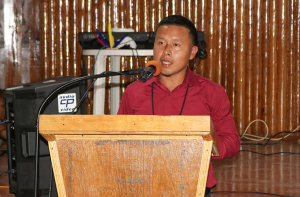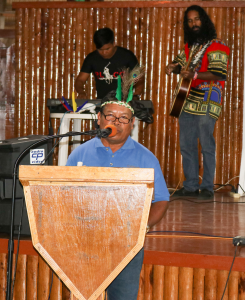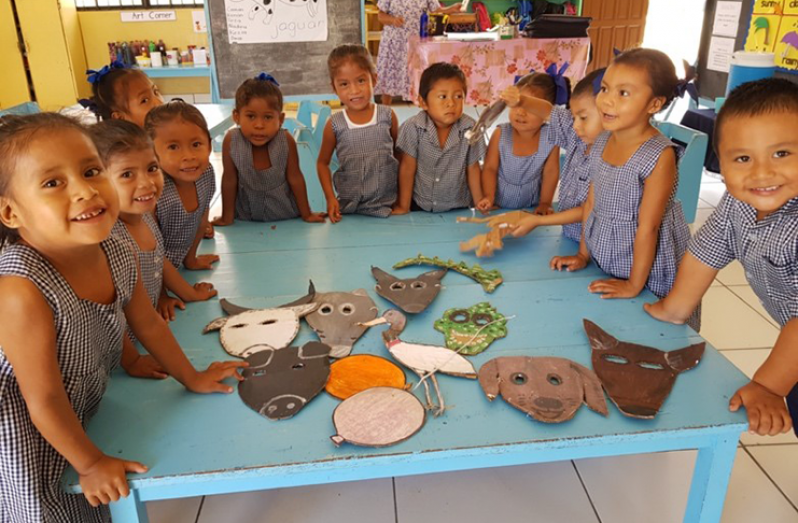By Gibron Rahim
GUYANA is the land of many languages. There is English, of course, but we are also home to Guyanese Creole and Akawaio, Arecuna, Carib, Lokono (Arawak), Macushi, Patamona, Waiwai, Wapichan and Warrau, the languages of our Indigenous Nations. For this reason, language preservation and linguistic diversity are rightfully issues of concern for our country. The decisions we make regarding these issues will have far-reaching implications for our collective future.
International Mother Language Day was proclaimed by the General Conference of the United Nations Educational, Scientific and Cultural Organization (UNESCO) in November 1999. Since 2000, it has been commemorated on February 21 each year with this year’s theme being “Languages without borders.” It aims to promote the preservation and protection of all languages used by people of the world and this is undoubtedly of significance to Guyana and its people.
There are multiple bodies tirelessly working to preserve Guyana’s linguistic heritage, including the Guyana Languages Unit (GLU), part of the Department of Language and Cultural Studies, Faculty of Education and Humanities at the University of Guyana, and the reasons are easily deciphered. The importance and effect of language preservation can be seen across multiple sectors of Guyana. The Pepperpot Magazine was able to speak with stakeholders in some of these sectors.

Dr. Deirdre Jafferally currently works as an independent consultant and country coordinator of the Darwin Initiative Project. In her current capacity, and in her past capacity as project manager of the Iwokrama International Centre, Dr. Jafferally has had extensive interaction with communities in the North and South Rupununi. She has learnt the importance of the land to the Indigenous People of those locations based on her experience. Language plays a role in the way they interact with and preserve their environment.
Dr. Jafferally pointed out that these languages are oral and said, “One of the things that we have to recognise is the way they think, the way they see the environment is completely different from the way we think, the way we see the environment.” Since, she explained, the language is based on interaction with each other, rather than writing, the way they think and portray events is completely different.
One notable point about language preservation was explained to Dr. Jafferally by Cecilia Jeffreys of Massara in the North Rupununi. She said that Jeffreys has always told her about the importance of keeping the Indigenous languages alive, especially as they relate to the names of places. “We have a tendency of trying to make [names] English or finding a translation and referring to it by the English name and she said, ‘No, learn the Macushi name,’” Dr. Jafferally related. “Because it explains so much more than it just being a location.” The name, she said, gives the stories behind those places.
Romario Hastings occupies a unique position as both an environmental officer with the Environmental Protection Agency (EPA) and a proud Kapohn which means “sky people” and is the name the people of the Akawaio Tribe use to individually and collectively refer to themselves. He explained that the connection between Indigenous Peoples and the environment is encompassed in their world view and preserved in their culture. The understanding there is that human beings are a part of their environment, even as that environment is a part of them. “You harming the natural world is basically harming yourself, that’s how communities see it.”
Hastings noted the role that Indigenous languages play in the transfer of values from generation to generation within each Indigenous culture. “Everything is transferred within the language, regardless of whether it has to do with environmental conservation [and] sustainability, traditional medicine, geography – all of the knowledge that exists for Indigenous People is embedded within their language,” he explained. He added, “In terms of making direct linkages between conservation, the ideas of conservation, and Indigenous livelihoods, it is communicated through their language.”
The oral nature of the Indigenous languages, as Hastings pointed out, means that the death of these languages also means the loss of the knowledge contained within them. This is a salient point because, he went on to say, “You can only understand certain concepts with the language itself, it may not be able to be directly expressed in English.” Further, attempts to translate such concepts into English, or another language may result in a different interpretation.
Attempts to preserve Indigenous languages are already having an impact on education. Silverius Perry is administrative coordinator of the Quality Bilingual Education Programme for Wapichan Children (QBEP) that is currently being piloted at three schools in the South Rupununi in Region Nine – Maruranau, Sawariwau and Karaudarnau Nursery Schools. He told the Pepperpot Magazine that the programme is a grassroots initiative by the Wapichan people in collaboration with the Ministry of Education and supported by the Jesuits in Guyana. Their main goal has been to provide quality education for Wapichan children.
With the help of the Jesuits, Wapichan communities identified their priority needs as education and the need to preserve their Wapichan identity. This was a result of the consistently high failure rate of children in the villages and the decline of Wapichan language and culture. Consequently, in 2015, the Jesuits invited Mr. Manoj Kitta, an educationalist, to gather data and information on the state of education in the three pilot South Rupununi schools. The key issue found by Kitta was that the students were being educated in English-medium schools though their first language was not English.
From these findings, Perry related that the idea was born to teach children in their native Wapichan first and introduce English as their confidence grew. In 2016, the proposed education programme was presented by local teachers and community members to the Education Commission of Inquiry in Aishalton where it was well-received. After engaging in dialogue with the Ministry of Education and the National Centre for Educational Resource Development (NCERD), a two-year Memorandum of Understanding was signed giving permission for the programme to be implemented in the pilot schools from September 2018.

In addition to Perry, Leah Casimero is the programme’s academic coordinator (Wapichan) and Marva Hawksworth acts as its early childhood consultant. A key aspect of the programme is the inclusion of Wapichan language and culture. Teachers of pilot schools are given the freedom to explain concepts bilingually to their students when necessary.
“If those children who enter nursery school, Wapichan speakers, have problems the teachers can speak to them in Wapichan,” Perry explained. “And those children who speak English, the teachers have to speak to them in English so that they [can] be comfortable in school.”
The programme also uses Wapichan storybooks created by local resource team members. In addition, every Friday, children wear their traditional clothing to school as part of building their identity.
Another key aspect of the programme is the inquiry-based learning approach being used in the pilot schools to attain the Ministry of Education’s national nursery standards. “Teachers just step back and guide the children so that they can discover for themselves what learning is,” Perry stated. He went on to relate that teachers have told him about the significant changes they have seen in their young charges for the first time in their teaching careers.
After the pilot phase ends in July this year, the bilingual education team, along with NCERD and the Ministry of Education, will evaluate the programme. The results have been promising thus far. While not an educator himself, Perry related that he has had some positive experiences over the past two years working with teachers, parents and children. “There is significant, visible evidence of this programme working for the teachers, for the children, for the parents,” he said.
Perry further explained that parents have been heartened by the fact that their children from the pilot schools often return home to share their learning experiences, Wapichan stories and songs which was something that had been non-existent with their older children.
Last year, 2019, marked the International Year of Indigenous Languages. It was a time to celebrate our Indigenous languages and the cultures from which they were born. However, the effort to preserve these languages continues, and simply documenting them is not enough. As Hastings noted, “The language and the knowledge itself exist within a thriving environment, whether it’s a cultural environment or a physical environment.” The loss or degradation of either results in the corresponding loss of knowledge. Clearly, the preservation and protection of Indigenous languages will take continued efforts on many fronts.



.jpg)








